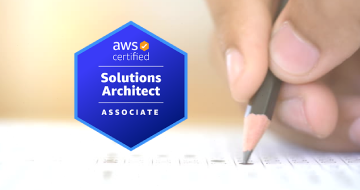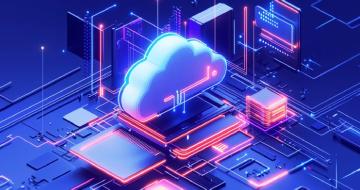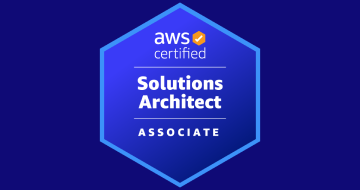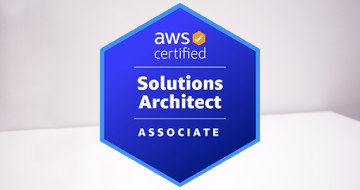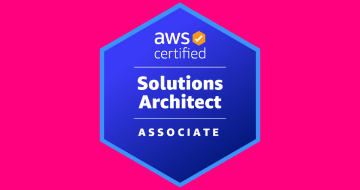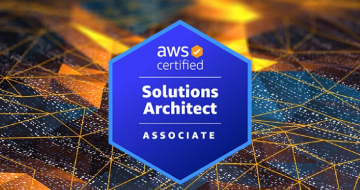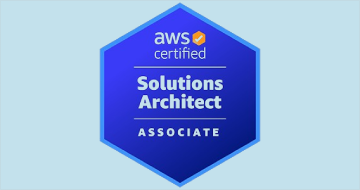IIRF Online > IT & Software > IT Certifications > AWS Certified Solutions Architect - Associate > AWS Certified Solutions Architect Associate - SAA C03
AWS Certified Solutions Architect Associate - SAA C03 by Udemy
AWS Certified Solutions Architect Associate - Updated for SAA C03
Course Highlights
- BONUS: 20 QUIZZES + 1 PRACTISE TEST + DOWNLOADABLE PDF
- PASS AWS Certified Solution Architect Associate
- Get HANDS-ON with AWS
- GET CERTIFIED - AWS Certified Solution Architect Associate
Skills you will learn!
Curriculum
4 Topics
DO NOT SKIP THIS: LEARN and WIN
Introduction - AWS Certified Solutions Architect Associate
Course Overview - AWS Certified Solutions Architect Associate
Course Downloads
3 Topics
Step 01 - Introduction to Cloud and AWS
Step 02 - Creating an AWS Root Account
Step 03 - Creating an IAM User For Your AWS Account
3 Topics
Step 01 - Need for Regions and Zones
Step 02 - Introduction to Regions and Availability Zones
AWS Introduction - Regions and Availability Zones
29 Topics
Step 00 - Section Overview - EC2
Step 01 - Exploring EC2 Fundamentals
Step 02 - Creating your first EC2 instance
Step 03 - Understanding EC2 instance type and SSH with Instance Con
Commands executed in next steps
Step 04 - Installing HTTP Webserver on EC2
Step 05 - Playing with EC2 Instance Metadata Service and Dynamic Data
Step 06 - 1 - Exposing EC2 dynamic data details on HTTP Web Server
Step 06 - 2 - JSON Viewer Plugin
Step 07 - Playing with EC2 Security Groups
Step 08 - Understanding EC2 Public and Private IP Addresses
Step 09 - Understanding Elastic IP Addresses
Update: IPV4 Addresses Are NOT FREE anymore
Release Elastic IP Address when you stop EC2 Instances
Step 10 - Simplify EC2 HTTP server setup
Do you want to help us?
EC2 Fundamentals Quiz
Launch Template User Data
Step 11 - Creating Launch Templates for EC2 instances
Step 12 - Creating Customized AMI for EC2 instance - Part 1
Step 13 - Creating Customized AMI for EC2 instance - Part 2
Step 14 - Exploring Amazon Machine Image
Step 15 - EC2 Security - Key Pairs
Step 16 - EC2 Security - Connecting from Windows
Step 17 - Key Pairs Recap & Troubleshooting
Step 18 - Important EC2 Scenarios
Step 19 - Choosing Availability Zone for EC2 Instance
Step 20 - Quick Review of EC2 - AMI Security Groups Key Pairs etc
EC2 Fundamentals 2 Quiz
2 Topics
Step 01 - Its Your Responsibility to Monitor Billing on the Cloud - 5 Recommenda
Step 02 - Monitor AWS Billing Setting Billing Alerts
28 Topics
Step 01 - Getting started with Load Balancing - AWS Elastic Load Balancing
Step 02 - Understanding HTTP HTTPS UDP and TCP Protocols
Step 03 - Exploring Types of AWS Elastic Load Balancers
Course Update: Gateway Load Balancer
Step 04 - AWS Elastic Load Balancing - Getting started with Classic Load Balance
Step 05 - Exploring Classic Load Balancer Further
Step 06 - AWS Elastic Load Balancing - Getting started with ALB
Do You Want to Help Others Like You?
Step 07 - Exploring Application Load Balancer Further
Step 08 - Understand AWS Elastic Load Balancing Listeners
Step 09 - Exploring Application Load Balancer Target Groups
Elastic Load Balancer
Step 10 - User data for microservice
Step 11 - Using Multiple Target Groups for Microservices Architectures
Step 12 - Exploring Listener Rules in ALB
Step 13 - Getting started with Auto Scaling Groups
Step 14 - Creating Your First Auto Scaling Group
Step 15 - Playing with Auto Scaling Group
Step 16 - Understanding Auto Scaling Components and Dynamic Scaling Policies
Step 17 - Exploring Auto Scaling Policies - Dynamic Scaling
Step 18 - Exploring Auto Scaling Scenarios
Step 18 - 2 - Deleting Application Load Balancers and Target Groups
Step 19 - Getting Started with a Network Load Balancer
Step 20 - Creating a Network Load Balancer
Step 21 - Exploring Network Load Balancer
Step 22 - Deleting Network Load Balancers and Target Groups
Step 23 - Quick Review of ELB - Application Classic and Network Load Balancers
Elastic Load Balancer - Advanced Quiz
28 Topics
Step 01 - Getting Started with EC2 & ELB For Architects
Step 02 - Understanding Availability
Step 03 - Understanding Scalability
Step 04 - Exploring EC2 Instance Families in AWS
Step 05 - Exploring Tenancy Options in EC2
Step 06 - Exploring Tenancy Options in EC2 - continued
Step 07 - Exploring EC2 Placement Groups
Step 08 - Exploring EC2 Placement Groups - Continued
Step 09 - Exploring Elastic Network Interface
Step 10 - Exploring Elastic Network Interface - Hands On
Step 10 - Monitoring EC2 Instances with Amazon CloudWatch
Step 11 - Understanding EC2 Pricing Models
Step 12 - Quick Overview of EC2 On Demand Instances
EC2 Advanced Quiz
Step 13 - Understanding EC2 Spot Instances
Step 14 - Launching Spot Instances
Step 15 - EC2 Spot Instances Pricing
Step 16 - Understanding EC2 Reserved Instances
Step 17 - Launching Reserved Instances
Step 18 - Exploring EC2 Instance Savings Plan
Step 19 - Quick Review of EC2 Pricing Models
Step 21 - Exploring Elastic Load Balancers Further
Step 22 - Understanding Server Name Indication
Step 23 - Monitoring & Troubleshooting Elastic Load Balancers
Step 24 - ALB vs CLB vs NLB
Step 25 - Exploring Important LoadBalancer Scenarios
Step 26 - Review of Architecture Considerations for ELB & EC2
EC2 and ELB - Final Quiz
6 Topics
Step 01 - Introduction to AWS Managed Services - IAAS PAAS CAAS FAAS and Serv
Step 02 - Introduction to AWS Elastic Beanstalk
Step 03 - Creating your first AWS Elastic Beanstalk environment with Python
Step 04 - Exploring AWS Elastic Beanstalk
Step 05 - AWS Elastic Beanstalk - A Quick Review
AWS Elastic Beanstalk Quiz
9 Topics
Step 01 - Getting Started with Microservices and Containers
Step 02 - Getting Started with Container Orchestration - ECS Fargate and Kubern
WARNING! BILLING ALERT! AWS Fargate is NOT in FREE TIER
Step 03 - Creating your first ECS Fargate cluster
Step 04 - Playing with the ECS Fargate Cluster - Tasks and Service
Step 05 - Quick Review of Elastic Container Service - ECS
Step 06 - Running Containers in AWS - A quick review
SAA C03 : Exploring Amazon ECS Anywhere & Amazon EKS Anywhere
Containers in AWS - Quiz
9 Topics
Step 01 - Introduction to Serverless with Lambdas
Step 02 - Creating your first AWS Lambda Function
Step 03 - Exploring Lambda Functions - Monitoring and more
Step 04 - Lambda Functions - Things to remember
Step 05 - Getting started with API Gateway
Step 06 - Creating your first API Gateway
Step 07 - Exploring API Gateway - Stages and more
Step 08 - Quick Review of API Gateway
Lambdas and API Gateway Quiz
25 Topics
Step 01 - Understand Need for VPC and Subnets
Step 02 - Exploring Default VPCs and Subnets
Step 03 - Getting started with IP Addresses - IPv4 and IPv6
Step 04 - Getting started with CIDR Blocks
Step 05 - Playing with Security Groups and CIDR Blocks
Step 06 - Choosing CIDR blocks for VPCs and Subnets
Step 07 - VPC and Subnet Demo - Create EC2 instances in Custom VPC Subnets
Step 08 - Exploring Private Subnets - No connection to instances
Step 09 - Exploring Routing and Route Tables in AWS
VPC Basics - Quiz
Step 10 - Creating an internet gateway and making subnets public
Step 11 - Quick Review of Internet Gateway in AWS VPC
Step 12 - Setting up Test API using API Gateway
Commands Executed : Setting up CronTabs in EC2 instances
Step 13 - Calling APIs from EC2 instances using crontab
Step 14 - Making Private Subnets Really Private
Step 15 - Exploring VPC NAT Devices - NAT Gateway and NAT Instance
WARNING! BILLING ALERT! NAT Gateway is NOT in FREE TIER
Step 16 - Creating a NAT Gateway to allow outbound traffic for private subnet
Step 17 - Understanding differences - NAT Gateway vs NAT instance
Step 18 - Quick Review - Few Questions about VPC and Subnets
Step 19 - Quick Review - Security Group Reference
Step 20 - Getting started with NACL
Step 21 - Understanding Differences between Security Group and NACL
VPC Final Quiz
34 Topics
Step 01 - Getting Started with S3 - AWS Object Storage
Course Downloads For S3
Step 02 - Creating an S3 Bucket and Exploring the UI
Step 03 - Understanding S3 - Objects Buckets and Key Value Pairs
Step 04 - Playing with S3 Versioning
WARNING! BILLING ALERT! Do NOT Enable Access Logging For Your Buckets
Step 05 - Logging S3 Access Requests
Step 06 - Creating a Public Website with S3
Step 07 - Quick Review - Creating a Public Website with S3
Step 08 - Exploring S3 Object level logging and Encryption
Step 09 - Exploring S3 Object Locks Tags and Transfer Acceleration
Course Update : Requestor Pays
Step 10 - Exploring S3 Event Notifications
S3 Quiz
Step 11 - Implementing S3 Event Notifications with AWS Lambda
Step 12 - Playing with S3 Prefixes
Step 13 - Exploring Bucket and Object ACLs in S3
Step 14 - Getting Started with S3 Storage Classes
Step 15 - Comparing S3 Storage Classes
Step 16 - Exploring S3 Lifecycle Configuration
WARNING! BILLING ALERT! Do NOT Enable CROSS Region Replication
Step 17 - Exploring S3 Cross Region and Same Region Replication
Step 18 - Exploring S3 Object Level Configurations
Step 19 - Understanding S3 Consistency Model - Eventual Consistency
Step 20 - Exploring S3 Presigned URLs
Step 21 - Basics of Amazon S3 Access Points
Step 21 - Exploring Different Cost Factors with Amazon S3
Step 22 - Quick Review of Amazon S3 Security Scenarios
Step 23 - Quick Review of Amazon S3 Cost Scenarios
Step 24 - Quick Review of Amazon S3 Performance Scenarios
Step 25 - Exploring S3 Features using Scenarios
Step 26 - Getting Started with S3 Glacier - S3 vs S3 Glacier
Step 27 - Exploring S3 Glacier - Quick Review
S3 Final Quiz
18 Topics
Step 01 - Getting Started with IAM - Identity and Access Management
Step 02 - Creating an Operations IAM User
Step 03 - Playing with IAM Users Groups and Policies
Step 04 - Understanding IAM AWS Managed and Customer Managed Policies
Step 05 - Exploring IAM Inline Policies
Step 06 - Connecting to AWS Services from Command Line
Step 07 - Creating an IAM role to connect to S3 from EC2
Step 08 - Quick Review of IAM - Users Roles and Groups
Step 08 - ZZ - Quick Introduction to Instance Profiles
Step 09 - Exploring IAM Scenarios
Step 10 - Exploring IAM Cross Account Access using Roles
Step 11 - Understanding Federation with IAM Roles
Step 12 - Understanding Web Identity Federation with IAM Roles
Step 13 - Exploring Identity Based and Resource Based Policies
Step 14 - Quick Review of IAM with Scenario Questions
Step 15 - Authentication with IAM - A Review
WARNING! BILLING ALERT! Terminate Your EC2 Instances
IAM Quiz
7 Topics
Step 01 - Understanding Data States Encryption KMS and Cloud HSM
Step 02 - Getting Started with AWS Key Management Service KMS
Step 03 - Connecting AWS KMS with S3 - Server Side Encryption SSE
Step 04 - How does Server Side Encryption Happen with KMS
Step 05 - Getting Started with AWS Cloud HSM
Step 06 - Quick Review of Cloud HSM
Data Encryption With KMS
28 Topics
Step 01 - Introduction to Storage Types - Block Storage and File St
Step 02 - Exploring Block Storage in AWS - Elastic Block Storage Instance Store
Step 03 - Exploring Block Storage in AWS - Instance Store
Step 04 - Exploring Block Storage in AWS - EBS - Elastic Block Storage
Step 05 - Understanding Differences Between Elastic Block Storage and Instance S
Block Storage - An update
Step 06 - Creating EC2 Instances with Elastic Block Storage Volumes
Step 07 - Playing with EC2 Instances and Elastic Block Storage Volumes
Step 08 - 1 - Mounting Elastic Block Storage onto a EC2 Instance
Step 08 - 2 - Mounting Elastic Block Storage onto a EC2 Instance
EBS Intermediate Quiz
Step 09 - Choosing Between EBS Storage Types - HDD vs SSD
Step 10 - Choosing Between EBS SSD Storage Types - General Purpose vs Provisione
Step 11 - Choosing Between EBS HDD Storage Types - Throughput Optimized Vs Cold
Step 12 - Comparing Four EBS Storage Types
Step 13 - Exploring Creation of Different EBS Storage Types
Step 14 - Getting Started with EBS Snapshots
Step 15 - Understanding EBS Snapshots in Depth
Step 16 - Encrypting Your EBS Volumes
Step 17 - Getting Faster IO performance between EBS Volumes and EC2 instances
Step 18 - Understanding EC2 Instance Lifecycle
Step 19 - Increase Availability or Fault Tolerance for EBS with RAID
Step 20 - Review Snapshots and AMIs - Using an AMI from a Different Region
Step 21 - Reviewing Amazon EBS - Scenarios with EC2 Instances
Step 22 - Reviewing Amazon EBS - Scenarios with Snapshots
Step 23 - Reviewing Amazon EBS - Final Refresh
Course Update: Attach a volume to multiple instances with EBS Multi-Attach
EBS Final Quiz
6 Topics
Step 01 - Getting Started with EFS - Elastic File Storage
Step 02 - Getting Started with FSX - Lustre and Windows File Servers
Step 03 - Creating an EFS Elastic File Storage
Step 04 - Sharing EFS File Storage between EC2 instances
Step 05 - Quick Review of Storage Options - File Object Block and Archival
Make Optimum Use of Resources in The Cloud
6 Topics
Step 06 - Getting Started with AWS Storage Gateway
Step 07 - Getting Started with AWS Storage File Gateway
Step 08 - Getting Started with AWS Storage Tape Gateway
Step 09 - Getting Started with AWS Storage Volume Gateway - Cached and Stored
Step 10 - Quick Review of AWS Storage Gateway
File Storage Quiz
17 Topics
Step 01 - Getting Started with Databases
Step 02 - Understanding Challenges with Choosing Databases
Step 03 - Understanding Availability and Durability of Databases
Step 04 - Understanding RTO and RPO
Step 05 - Understanding Read Replicas for Databases
Quick Update : Read Replicas are supported for MS SQL Server
Step 06 - Understanding Importance of Database Consistency
Step 07 - Exploring Different Database Categories
Step 08 - Exploring Relations Databases for OLTP and OLAP Use cases (RDS and Red
Step 09 - Exploring the differences between OLTP and OLAP Databases
Step 10 - Getting Started with Document Databases (DocumentDB)
Step 11 - Exploring Key Value Databases (DocumentDB)
Step 12 - Quick Look at Graph Databases (Neptune)
Step 13 - Quick Look at In Memory Databases (ElastiCache)
Step 14 - Quick Review of Database Options
Step 15 - Scenarios Review of Database Options
Getting Started with Databases - Quiz
20 Topics
Step 01 - Getting Started with RDS - AWS Relational OLTP Database
Step 02 - Responsibilities for RDS - You vs AWS
Step 03 - Exploring options in creating RDS Databases
Step 04 - Creating Your First RDS Database in AWS
Step 05 - Creating an EC2 instance to connect to RDS Database
Commands executed in next step
Step 06 - Connecting to RDS Database from EC2 instance and creating tables
Step 07 - Exploring Options on an Existing Your First RDS Database in AWS
Step 08 - Understanding Multi AZ Deployments of RDS
Step 09 - Understanding Read Replicas of RDS
Step 10 - Getting Started with Amazon Aurora Database
Step 11 - Exploring UI for Amazon Aurora Database
Step 12 - Exploring Other RDS Database Engines]
Step 13 - Architecture - Managing Scaling of Your RDS Databases
Step 14 - Architecture - Managing Operations for RDS Databases
Step 15 - Architecture - Managing Security and Encryption for RDS
Step 16 - Architecture - Managing Costs for Your RDS Databases
Step 17 - Quick Review - When to use RDS
Step 18 - RDS Review with A Few Scenarios
RDS Quiz
17 Topics
Step 01 - Getting Started with Amazon DynamoDB
Step 02 - Understanding Amazon DynamoDB Tables
Step 03 - Creating an Amazon DynamoDB Table
Step 04 - Exploring Amazon DynamoDB Tables
Step 05 - Exploring Amazon DynamoDB Global Secondary Indexes
Step 06 - Exploring Amazon DynamoDB Table Operations
Step 07 - Creating Amazon DynamoDB Table with Both Partition and Sort Keys
Step 08 - Exploring Amazon DynamoDB Indexes
Step 09 - Understanding Amazon DynamoDB Query vs Scan
Step 10 - Understanding Amazon DynamoDB Consistency Levels
Step 11 - Understanding Amazon DynamoDB Read Write Capacity Modes
Step 12 - Understanding Amazon DynamoDB RCU and WCU
Step 13 - Understanding Amazon DynamoDB Operations IAM and Encryption
Step 14 - Review - RDS vs DynamoDB
Step 15 - Exploring DAX DynamoDB Accelerator
WARNING! BILLING ALERT! Delete DynamoDB Tables
DynamoDB Quiz
8 Topics
Step 01 - Getting Started with Amazon ElastiCache
Step 02 - Getting Started with Amazon ElastiCache for Redis
Step 03 - Exploring Amazon ElastiCache for Redis
Step 04 - Quick Review of Amazon ElastiCache for Redis
Step 05 - Getting started with Amazon ElastiCache for Memcached
Step 06 - Amazon ElastiCache for Redis vs Memcached
SAA C03 Update: Quick Review of Important AWS Databases
Amazon ElastiCache Quiz
11 Topics
Step 01 - Getting Started with AWS CloudTrail
Step 02 - Exploring AWS CloudTrail
WARNING! BILLING ALERT! AWS Config and Config Rules are NOT in FREE TIER
Step 03 - Getting Started with AWS Config and AWS Config Rules
Step 04 - Configuring AWS Config and AWS Config Rules
Step 05 - Exploring Results from AWS Config and AWS Config Rules
Step 06 - Getting Started with Amazon CloudWatch
Step 07 - Exploring Amazon CloudWatch - Dashboards Alarms and Logs
Step 08 - Exploring Amazon CloudWatch - Metrics Events and Container Insights
Step 08 - Quick Review of Amazon CloudWatch
AWS Services Quiz
15 Topics
Step 01 - Understanding Need for Asynchronous Communication
Step 02 - Getting Started with SQS
Step 03 - Sending and Receiving a Messaging using SQS - Best Case
Step 04 - Understanding Lifecycle of a Message on a SQS Queue
Step 05 - Implementing AutoScaling with SQS
Step 06 - Understanding Important SQS Configuration
Step 07 - Implementing Security for Your SQS Queues
Step 08 - 01 - Creating an Amazon SQS Queue and Playing with Messages
Step 08 - 02 - Sending and Receiving SQS Messages from an EC2 instance
Step 08 - Exploring Different Scenarios with SQS Queues
Step 09 - Getting Started with Simple Notification Service - SNS
Step 09 - 01 - Creating an SNS Topic and Registering a Lambda to Subscribe
Step 09 - 02 - Registering an SQS Queue as a subscriber to an SNS Topic
Step 10 - Getting Started with Amazon MQ
Decoupling Quiz
11 Topics
Step 01 - Understanding the Need for CDN - CloudFront
Step 02 - Getting Started with Amazon CloudFront
Step 03 - Understanding a Amazon CloudFront Distribution
Step 04 - Setting Cache Behaviors for Amazon CloudFront Distribution
Step 05 - Creating Private Content with Amazon CloudFront
Step 06 - Creating Signed URLs and Cookies with Amazon CloudFront
Step 07 - Protecting content in S3 using Amazon CloudFront OAI
Step 08 - 01 - Creating a CloudFront Distribution
Step 08 - 02 - Exploring CloudFront Distribution
Step 08 - Quick Review of Amazon CloudFront
Content Distribution Quiz
10 Topics
Step 01 - Getting Started with Route 53 - AWS Domain Registrar and DNS
Step 02 - Understanding Route 53 - DNS Records and Alias Records
Step 03 - Understanding Route 53 Routing Policies
WARNING! BILLING ALERT! HOSTED ZONES are NOT in FREE TIER
Step 04 - Creating a Hosted Zone with Route 53 and Exploring Routing Policies
Step 05 - Exploring Route 53 Routing Policies - 1
Step 06 - Exploring Route 53 Routing Policies - 2
Step 07 - Exploring Route 53 Routing Policies - 3
WARNING! BILLING ALERT! Delete the Hosted Zone and Terminate all EC2 Instances
Route 53 Quiz
1 Topic
Switching to Architecture Mode
12 Topics
Step 01 - Getting Started with Amazon RedShift
Step 02 - Understanding a Amazon RedShift Cluster
Step 03 - Designing Tables for Amazon RedShift - 3 important considerations
Step 04 - Loading Data into Amazon RedShift
Step 05 - Managing Your RedShift Workloads WLM
Step 06 - Understanding Amazon RedShift Security - KMS and IAM
Step 07 - Doing a few miscellaneous operations with Amazon RedShift
Exploring RedShift
Step 08 - Getting Started with Amazon RedShift Spectrum
Step 09 - Getting Started with Amazon EMR - Your Managed Hadoop Service in AWS
Step 10 - Exploring Amazon RedShift and EMR Alternatives
ETL Big Data Quiz
7 Topics
Step 01 - Getting Started with AWS Data Lakes
Step 02 - Understanding AWS Data Lakes Storage and Ingestion Options
Step 03 - Understanding AWS Data Lakes Query in Place Options
Step 04 - Understanding AWS Data Lakes Analytics Integrations
Step 05 - Exploring Data Cataloging with AWS Data Lakes
Exploring Big Data Datawarehouses and Data Lakes in AWS
Data Lakes Quiz
10 Topics
Step 01 - Getting Started with Streaming Data
Step 02 - Handling simple streams with S3 Notifications
Step 03 - Handling simple streams with DynamoDB Streams
Step 04 - Getting Started with Amazon Kinesis
Step 05 - Getting Started with Amazon Kinesis Data Streams
Step 06 - Getting Started with Amazon Kinesis Data Firehose
Step 07 - Getting Started with Amazon Kinesis Analytics
Step 08 - Getting Started with Amazon Kinesis Video Streams
Step 09 - Exploring Amazon Kinesis
Streaming Data - Quiz
12 Topics
Step 01 - Exploring Serverless Options in AWS
Step 02 - Quick Review of API Gateway
Step 03 - Implementing Authentication with API Gateway
Step 04 - Getting Started with Amazon Cognito for Authentication and Authorizati
Step 05 - Understanding Cognito User Pools and Identity Pools
Step 06 - Quick Overview of How Cognito Works
Step 07 - Getting Started with Lambda at EDGE
Step 08 - Quick Overview of Serverless Application Model
Step 09 - Getting Started with AWS AppSync
Step 10 - Serverless Orchestration with AWS Step Functions
Step 11 - Exploring AWS Step Functions
Serverless Quiz
12 Topics
Step 01 - Getting Started with VPC Peering
Step 01 - 02 - Exploring VPC Peering
Step 02 - Understanding VPC Endpoints - Gateway and Interface
Step 03 - Troubleshoot Security Groups and NACLs using VPC Flow Logs
Step 04 - Connecting AWS with On Premise Network - Direct Connect and VPN
Step 05 - Exploring AWS Managed VPN
Step 06 - Exploring AWS Direct Connect
Step 07 - Exploring AWS Direct Connect plus VPN
Step 08 - Quick Introduction to Software VPN
Step 09 - Quick Introduction to AWS VPN CloudHub
SAA C03 Update: Exploring AWS Transit Gateway - multiple VPCs with on prem
Connecting AWS with On Premise Data Centers - Quiz
10 Topics
Step 01 - Moving Data from On Premises to AWS
Step 02 - Exploring S3 Transfer Acceleration
Step 03 - Using AWS Snowball to Transfer Data
Step 04 - Exploring AWS Snowmobile
Step 05 - Transfer File Storage to Cloud with AWS DataSync
Step 06 - Connecting Data Processing Flows with AWS DataPipeline
Step 07 - Migrating Databases with AWS Database Migration Service
Step 08 - Converting Schemas using AWS SCT
SAA C03 Updates: Migrating Applications to AWS
Moving Data from On Premises to AWS - Quiz
9 Topics
Step 01 - Getting Started with DevOps
Step 02 - Getting Started with CI CD
Step 03 - Getting Started with IAAC - Infrastructure Provisioning and Server Con
Step 04 - Getting Started with AWS CloudFormation
Step 05 - Exploring AWS CloudFormation Templates
Step 06 - Exploring AWS CloudFormation Terminology
Step 07 - AWS CloudFormation vs AWS Elastic Beanstalk
Step 08 - Getting Started with AWS OpsWorks
DevOps Quiz
2 Topics
Step 01 - Understanding Data Transfer Costs
Step 02 - Exploring High Availability and Fault Tolerance
8 Topics
Step 01 - Understand AWS Shield - Protect from DDoS
Step 02 - Understand AWS WAF - Protect Your Web Applications
Step 03 - Introduction to Amazon Macie
Step 04 - Getting started with AWS Single Sign On
Step 05 - Quick Overview of AWS Systems Manager Parameter Store
Step 06 - Quick Overview of AWS Secrets Manager
SAA C03 Updates : AWS STS
SAA C03 Update: Exploring More Security Services in AWS
11 Topics
Step 01 - Exploring AWS Trusted Advisor
Step 02 - Exploring AWS Organizations
SAA C03 Update: AWS Control Tower - Setup multi account AWS environment
Step 03 - Exploring Service Quotas
Step 04 - Exploring AWS Directory Service
Step 05 - Exploring AWS Global Accelerator
Step 06 - Introduction to AWS Elemental Media Convert
Step 07 - Quick Overview of AWS Workspaces
Step 08 - Getting Started with Amazon Simple Workflow Service - SWF
Step 09 - Getting started with AWS Elasticsearch
More AWS Services Quiz
3 Topics
SAA C03 Update - Exploring Observability in AWS
SAA C03 Update - Exploring AWS Proton
SAA C03 Updates - Managing Costs in AWS - Managed Services and Best Practices
2 Topics
SAA C03 Updates: Getting Started with Machine Learning in AWS
SAA C03 Updates: Exploring Machine Learning Services in AWS
14 Topics
Step 01 - Well Architected Framework - Introduction
Step 02 - Well Architected Framework - Operational Excellence Pillar
Step 03 - Well Architected Framework - Security Pillar - 1
Step 04 - Well Architected Framework - Security Pillar - 2
Step 05 - Well Architected Framework - Reliability Pillar
Step 06 - Well Architected Framework - Loosely Coupled Architectures
Step 07 - Well Architected Framework - Troubleshooting on AWS
Step 11 - Shared Responsibility Model - AWS and Customer - Security & Compliance
Step 08 - Well Architected Framework - Performance Efficiency Pillar
Step 09 - Well Architected Framework - Performance Efficiency Pillar - Choosing
Step 10 - Well Architected Framework - Cost Optimization Pillar
Step 11 - 6th AWS Well Architected Pillar - Sustainability
Step 12 - Exploring AWS Cloud Adoption Framework
Well Architected Framework Quiz
6 Topics
Step 01 - Assess your preparation - AWS Certified Solutions Architect Associate
Step 02 - Recommended Reading - AWS Certified Solutions Architect Associate
SAA C03 Update: Register for SAA C03
Step 03 - Register for AWS Certified Solutions Architect Associate exam
Step 04 - My Recommendations for the AWS Certified Solutions Architect Exam
Step 05 - Congratulations - AWS Certified Solutions Architect Associate
1 Topic
Practice Test
1 Topic
Bonus Lecture
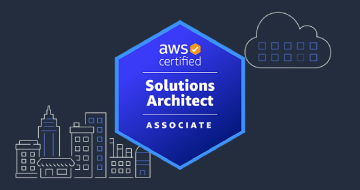
AWS Certified Solutions Architect Associate - SAA C03
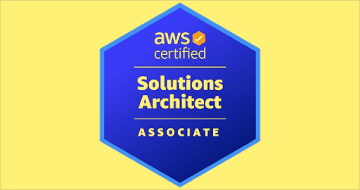
 - Training.webp)
